Nutrition
Food Planning
-
1kg of butter/coconut oil
-
1.75kg grass fed ground beef (525-560g dehydrated)
-
1.5kg veggies (250-300g dehydrated)
-
1kg of lean grass fed beef, sliced thin for jerky (300-350g dehydrated)
-
200g dried, powdered cream (milk powder/coconut milk powder are sugar heavy substitutes)
-
350g nuts
-
200g dark chocolate
-
200g cheese
-
250g salami
Day 21 – August 17th 2017
20:15 Camp in center of Kaskasavagge
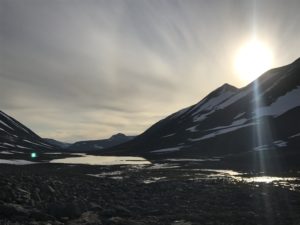
Sitting in my tent looking through the valley towards Kungsleden in the far distance and enjoying the reflection of the beautiful evening sky in the perfectly still water of the lake in front of me. For the first night in quite a while I don’t need to hide in my sleeping bag to stand the cold or camp by a cabin to get dried up.
And that’s not the way this day started out…
I woke up rather early around half past six to the sound of… (drumroll!) raindrops falling on my tent again. The rain that started during my hike yesterday hadn’t really stopped – rather just taken very short breaks during the night. I even had a light rain falling when I put up the tent last night.
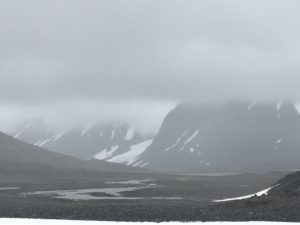
During one of the breaks I grabbed most of my stuff, except sleeping bag, mattress and, of course, the tent, and relocated into the kitchen of the closest cabin to make some coffee and start the day.
Naturally I met the same people as yesterday and had a very sociable morning and was able to help quite a few people with tips and ideas for the continuation of their tours.
Twice I was out wiping of the tent before finally it stopped raining for about half an hour and got my stuff packed reasonably dry.
In the meantime I got an interview with one of the hosts, which we had to do inside due to the weather. It was after half past eleven before I finally got away from Sälka and onto the trail towards Nallo.
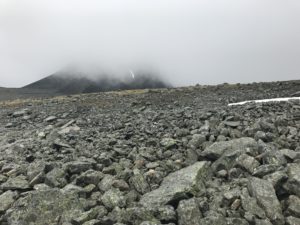 Using the trail kept me roughly away from the wet bushes and scrubs, thereby helping to avoid soaking the boots within the first few km.After about 7km I left the trail and started working my way up the mountain side and turn into the western part of Unna Reiddasvagge. The ground was almost inconceivably drenched were there were no rocks and the rocks themselves were wet and slippery. Approaching the opening of the valley I suddenly found myself at about the same elevation as the clouds and really thought it’s have to hike in fog for the rest of that part.
Using the trail kept me roughly away from the wet bushes and scrubs, thereby helping to avoid soaking the boots within the first few km.After about 7km I left the trail and started working my way up the mountain side and turn into the western part of Unna Reiddasvagge. The ground was almost inconceivably drenched were there were no rocks and the rocks themselves were wet and slippery. Approaching the opening of the valley I suddenly found myself at about the same elevation as the clouds and really thought it’s have to hike in fog for the rest of that part.
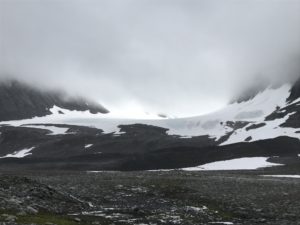
Thankfully the clouds lifted and I had a wet and cold hike with good visibility up to the Unna Räitas cabin. This is one of the few cabins without a host and frankly it is pretty worn down and would definitely need some love and construction work. Now it’s more like an emergency shelter, I can’t imagine anyone wanting to sleep there except for a real emergency.
Location is just fantabulous, though, with a view of the Reaidda glacier, a beautiful meltwater lake and several summits at around 1900m.
Here I had my midday break with some tea and snacks, and while I was inside getting my stuff prepared out of the cold wind the miracle happened.
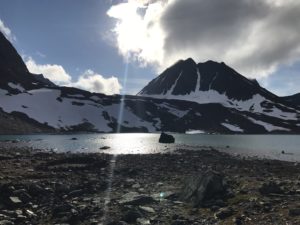
Within less than an hour the clouds opened up and revealed blue sky and sunshine, I dare to admit that I had to really look around to believe the change that had happened. This I had been wishing and praying for for days now and finally we got a nice and clear afternoon sky again.
Knowing that I’d be doing the pass crossing, I still had a thorough break before departing from the cabin and approaching the climb.
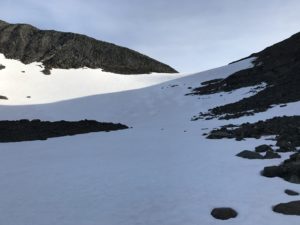
Not only was the snow field large enough to allow the crossing, most of the ascent could be done on snow, which is so much easier on joints and ligaments then hiking rocks, and I reached the summit of the pass after just an hour. The view was marvelous and well worth the climb, unfortunately pictures can’t show how steep it really is. I really had to kick my boots into the snow wall to be able to climb it without slipping and sliding back downhill.
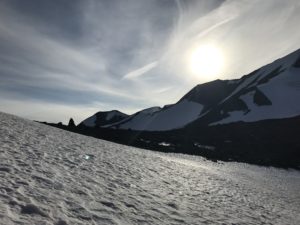
Naturally the decent into Kaskasavagge was less physically demanding, yet it’s quite taxing mentally to keep focus on where to step next. There was some snow fields on the way down as well, yet mostly rocks, which thankfully had dried completely since the rain stopped. And what a different experience it is to walk on dry rocks compared to having them wet and slippery.
Already on the decent I spotted a possible camp site and even if I checked a few others I ended up in the place. Right in the middle of the valley and close to a stream it makes a perfect spot for me and a good starting point for tomorrow’s hike.
Now I just hope and pray that this preferable weather change will stick for a while. I’d love the weather to be like this for the remainder of my tour!
The journey continues, please leave a comment to tell me what You think and share this with friends and loved ones who might benefit or be interested!
By leaving Your name and email in the box below You get notification of futures posts and news!
Keto Hiker is becoming a reality!
Just under three weeks from now I start a hike that´s developed into a “N=1 scientific experiment”, meaning we do a study of just one subject, me!
I go into the north Swedish mountains for 4 weeks carrying all my provisions from start to be able to control nutrition and consume only ketogenic food. In collaboration with an endocrinologist in Stockholm we do extended blood work before and after.
During the entire tour I’ll be measuring with a Ketonix meter, Michel Lundell has been kind enough to sponsor the project with his latest model and Christofer Kelly from Nourish Balance Thrive is contributing their MCT powder and a couple of DUTCH tests as well as supporting with knowledge.
The basic idea is to take a rather over averagely healthy 46 year old male (that´s me) and put him in a more or less hunter/gatherer situation (except I carry my food instead of killing it along the way) for just over four weeks.
No planned social interactions, no connectivity (that´s no FB, email, cell phone connection… not even snail mail) – just moving through beautiful nature and following the natural rhythm of the body.
Eat when hungry, sleep when tired, move daily, rest as much as needed. Detached from civilization and connecting back with our origin, in a safe and relaxed way using a familiar environment to really remove any stressors as much as humanly possible.
We naturally expect any not so good markers to be reversed and the good ones turning out even better!
So, needless to say I´m stoked and looking forward to see the results of this adventure, stay tuned, check out the short video and, please share with people You know who might be interested or benefit!
Again, please leave a comment to tell me what You think and share this with friends and loved ones who might benefit or be interested!
By leaving Your name and email in the box below You get notification of futures posts and news!